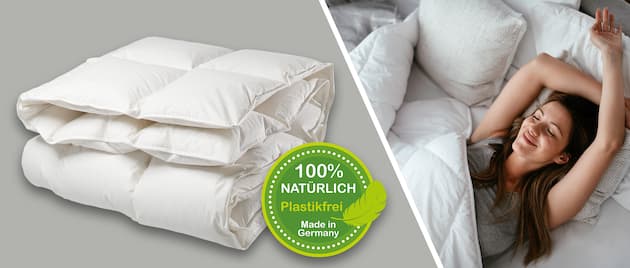Would you like to sleep well, wake up refreshed and have the most comfortable night possible? Then down as a filling for your duvets is always worth recommending. In this article, we explain what makes down and feathers so special, how to recognize the best down comforter and what else you should pay attention to.
Down and feathers, which are a by-product of fattening geese and ducks, are commonly used for filling bedding. Duvets that have at least 60 percent down in the filling may be called down duvets. If the proportion of down is lower, it is called a feather bed. Down and feathers have many advantages that make them the ideal filling material for good duvets and the best pillows.
Elasticity:
Down is very elastic and will always return to its original shape when compressed. The best duvets, which hardly lose any bulking power, are filled with down.
Breathability:
Down and feathers are breathable and moisture-regulating. They absorb the moisture we sweat out while we sleep and wick it away again via the surface of the duvet. Due to this temperature-balancing nature, they ensure an airy, dry sleeping climate.
thermal insulation:
Down fillings retain body heat particularly well. Down has a flake-like structure and can trap a large amount of warm air. The higher the proportion of down in the filling, the better the thermal properties of the blanket.
Sustainable and close to nature:
Down and feathers are a purely natural product. They are free of pollutants, conserve natural resources and can be disposed of in an environmentally friendly manner.
Down comforters are commonly available in five degrees of warmth:
1: summer duvet
2: Summer half-year
3: winter half-year
4: winter duvet
5: WinterPlus for particularly cold sleeping environments
If the bedroom temperature changes noticeably over the course of the year, many people use different duvets. However, if your bedroom temperature remains the same throughout the year and you do not have a high need for warmth, a 4-season down duvet can accompany your sleep all year round. This saves money and space.
Down and feathers are obtained from fattening animals. Ducks are only plucked after slaughter, geese can be plucked alive several times before slaughter. This is associated with pain, stress and fear for the animals and is now banned in the EU. The Downpass seal provides a good indication of how down was obtained. In the case of down products that are equipped with this seal, live plucking and the agonizing force fattening were dispensed with.
The classic down duvet from the past is called a balloon duvet. The down-feather mixture is simply poured into the cover. This causes the filling to often pool at one end. So that the blanket warms everywhere, it is very generously filled and has a relatively high weight.
In the case of quilts or coffered quilts, the top and bottom are sewn together in a check pattern to prevent the filling from slipping. With quilts, the top and bottom are sewn directly together. In the case of coffered ceilings, tapes are incorporated into the seams. This creates individually filled pockets that, remote from the structure, are reminiscent of honeycombs. Cold bridges can be avoided and the blanket warms better.
The blanket cover is also called ticking and is usually made of cotton fabric. The quality or grade of ticking is given in Nm (number metric). The higher the Nm specification, the higher the quality of the material used. The inlets for the best duvets with down fillings start from 100 Nm. From this value, the fabric is so dense that no quills can escape or dust and dirt can get into the filling.
In order to support the breathable and moisture-wicking nature of the down, the cover should always be made of cotton or other natural fibers. People with allergies and sensitive skin should pay attention to the Oeko-Tex seal, as this ensures that no harmful substances are emitted. In addition, other seals such as Downafresh guarantee the hygiene of the processed down and feathers.
rustling of down comforters
Some people find the rustling of down comforters disturbing. But not all down comforters rustle equally. If the ceiling filling contains a larger proportion of feathers, more noise is to be expected. The reason is the hard quills that cause friction. A higher percentage of down can help.
The ceiling shell can also cause noise. Especially thick and high-quality fabric rustles louder because it has a higher fiber content and thus creates more friction. However, down comforters become quieter with age, as the possible friction surfaces wear out over time.
Because down and feathers can wear out or buckle over time, the best down comforter and even the best pillow lose quality. With good care and regular airing, good down duvets can last up to 15 years. After that, they should be replaced or processed.
Alternatively, down comforters can be processed. During processing, damaged down and feathers are sorted out of the quilt, the remaining filling is cleaned and finally filled with new down and feathers. This procedure can be carried out well for balloon ceilings. They have a particularly long service life.
In the case of quilts and coffered quilts, the filling is in the individual chambers. It has to be painstakingly removed. Reprocessing these ceilings is comparatively expensive and time-consuming, so replacing them is often the better alternative.
In summary, a good, durable down comforter should be of high quality. Avoiding live plucking and force fattening should play a role. All raw materials should also be of natural origin. Cassette quilting serves to optimally distribute the down filling in the down duvet, which avoids cold bridges. Certificates such as Oeko-Tex, Nomite, Downafresh and Downpass serve as quality features.
Do you already know federiko down comforters? These score with all the criteria for the best down comforter. In addition, they are characterized by handmade production in Germany. Discover federiko quality now:
Surf tips:
